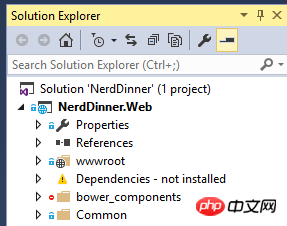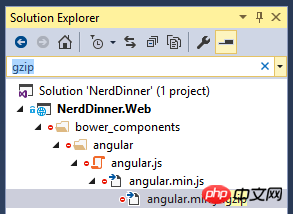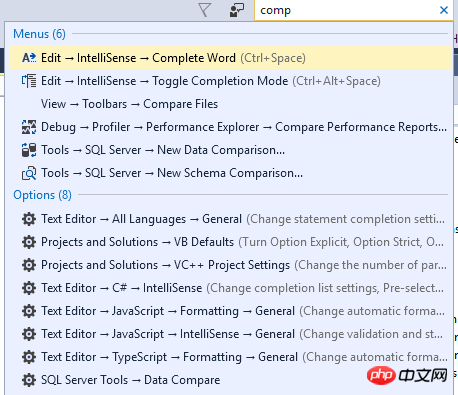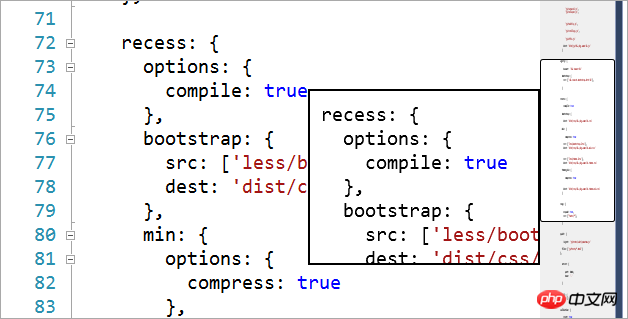Tips for using Visual Studio
There is a joke about Microsoft Office, saying that it has too many features:
Just when you think you've discovered a new feature of Office, it's been around for years.
This article will introduce some useful but overlooked tips in Visual Studio (free download).
Use CTRL+; Search Solution Explorer
You can click on the Solution Explorer text box (or use the shortcut "CTRL+;") to search for all nodes - whether hidden or visible.

Searchable even if deeply folded. Search results remain until you clear the search box.

Quickly open
via CTRL+Q If there's a feature that everyone should use, but no one actually uses, it should be quick opening.
Generally speaking, we use menus to find a function, such as opening tools... options... etc.
Just press Ctrl+Q and enter the keyword. For example, to change the font size:

Another example, what if you want to compare files? Do you know that VS also has this function?

You can also find a NuGet package faster than NuGet Dialog:

Just use this feature for a few days and you'll develop a habit. You will thank yourself in the future.
Show overview in scrollbar
What I like most is when I show people some features and they look surprised that "this function even exists." Find "map mode" in Quick Open, then open it, and you can see this effect.

Your scroll bar can display a thumbnail when you hover over it to help you navigate your files.

TAB management
This is how most people use TAB tabs:
Open a TAB
Repeat the above
There are too many TABs opened, it’s confusing
Close all TAB
Back to 0
You can use "fixed tabs" and "tab preview".

You can pin commonly used tabs, and then when closing, no longer select "Close all tabs" but "Close tabs except pinned tabs"

In addition, if you want to view a file, do not always double-click to open a file in the explorer, which will open a new tab. Using a standalone machine, a preview can be generated on the right. This way you won't clutter the tabs.
Use CTRL+to locate
This is undoubtedly the most prominent feature in this article. Why use mouse positioning? Press Ctrl+, enter a file, member variable or function, select it from the pop-up menu, and then navigate to that place.
If you know the name of what you're looking for, you don't need to use Explorer at all. Use Ctrl+, which is faster.

Use keyboard to move code
Visual Studio is not Emacs or Vim (unless you want it to be VSVim), but there are some advanced features that people generally don't know about.
You can move code using alt+up and down keys, which is rarely used in practice. You can also directly use the Shift+Select keys to select the code and then move it.

You can also use block selection: hold Alt and drag, so you can edit several lines at the same time.
Maybe you already know these features, or maybe you learned something. I think it's more important to realize that there are a lot of features out there waiting to be discovered. Do you have any little-known tricks?
Original text: Visual Studio’s most useful (and underused) tips
The above is the detailed content of Tips for using Visual Studio. For more information, please follow other related articles on the PHP Chinese website!

Hot AI Tools

Undresser.AI Undress
AI-powered app for creating realistic nude photos

AI Clothes Remover
Online AI tool for removing clothes from photos.

Undress AI Tool
Undress images for free

Clothoff.io
AI clothes remover

Video Face Swap
Swap faces in any video effortlessly with our completely free AI face swap tool!

Hot Article

Hot Tools

Notepad++7.3.1
Easy-to-use and free code editor

SublimeText3 Chinese version
Chinese version, very easy to use

Zend Studio 13.0.1
Powerful PHP integrated development environment

Dreamweaver CS6
Visual web development tools

SublimeText3 Mac version
God-level code editing software (SublimeText3)

Hot Topics
 1662
1662
 14
14
 1418
1418
 52
52
 1311
1311
 25
25
 1261
1261
 29
29
 1234
1234
 24
24
 C# .NET Interview Questions & Answers: Level Up Your Expertise
Apr 07, 2025 am 12:01 AM
C# .NET Interview Questions & Answers: Level Up Your Expertise
Apr 07, 2025 am 12:01 AM
C#.NET interview questions and answers include basic knowledge, core concepts, and advanced usage. 1) Basic knowledge: C# is an object-oriented language developed by Microsoft and is mainly used in the .NET framework. 2) Core concepts: Delegation and events allow dynamic binding methods, and LINQ provides powerful query functions. 3) Advanced usage: Asynchronous programming improves responsiveness, and expression trees are used for dynamic code construction.
 C# .NET: Exploring Core Concepts and Programming Fundamentals
Apr 10, 2025 am 09:32 AM
C# .NET: Exploring Core Concepts and Programming Fundamentals
Apr 10, 2025 am 09:32 AM
C# is a modern, object-oriented programming language developed by Microsoft and as part of the .NET framework. 1.C# supports object-oriented programming (OOP), including encapsulation, inheritance and polymorphism. 2. Asynchronous programming in C# is implemented through async and await keywords to improve application responsiveness. 3. Use LINQ to process data collections concisely. 4. Common errors include null reference exceptions and index out-of-range exceptions. Debugging skills include using a debugger and exception handling. 5. Performance optimization includes using StringBuilder and avoiding unnecessary packing and unboxing.
 Testing C# .NET Applications: Unit, Integration, and End-to-End Testing
Apr 09, 2025 am 12:04 AM
Testing C# .NET Applications: Unit, Integration, and End-to-End Testing
Apr 09, 2025 am 12:04 AM
Testing strategies for C#.NET applications include unit testing, integration testing, and end-to-end testing. 1. Unit testing ensures that the minimum unit of the code works independently, using the MSTest, NUnit or xUnit framework. 2. Integrated tests verify the functions of multiple units combined, commonly used simulated data and external services. 3. End-to-end testing simulates the user's complete operation process, and Selenium is usually used for automated testing.
 From Web to Desktop: The Versatility of C# .NET
Apr 15, 2025 am 12:07 AM
From Web to Desktop: The Versatility of C# .NET
Apr 15, 2025 am 12:07 AM
C#.NETisversatileforbothwebanddesktopdevelopment.1)Forweb,useASP.NETfordynamicapplications.2)Fordesktop,employWindowsFormsorWPFforrichinterfaces.3)UseXamarinforcross-platformdevelopment,enablingcodesharingacrossWindows,macOS,Linux,andmobiledevices.
 The Continued Relevance of C# .NET: A Look at Current Usage
Apr 16, 2025 am 12:07 AM
The Continued Relevance of C# .NET: A Look at Current Usage
Apr 16, 2025 am 12:07 AM
C#.NET is still important because it provides powerful tools and libraries that support multiple application development. 1) C# combines .NET framework to make development efficient and convenient. 2) C#'s type safety and garbage collection mechanism enhance its advantages. 3) .NET provides a cross-platform running environment and rich APIs, improving development flexibility.
 Advanced C# .NET Tutorial: Ace Your Next Senior Developer Interview
Apr 08, 2025 am 12:06 AM
Advanced C# .NET Tutorial: Ace Your Next Senior Developer Interview
Apr 08, 2025 am 12:06 AM
Interview with C# senior developer requires mastering core knowledge such as asynchronous programming, LINQ, and internal working principles of .NET frameworks. 1. Asynchronous programming simplifies operations through async and await to improve application responsiveness. 2.LINQ operates data in SQL style and pay attention to performance. 3. The CLR of the NET framework manages memory, and garbage collection needs to be used with caution.
 Is C# .NET Right for You? Evaluating its Applicability
Apr 13, 2025 am 12:03 AM
Is C# .NET Right for You? Evaluating its Applicability
Apr 13, 2025 am 12:03 AM
C#.NETissuitableforenterprise-levelapplicationswithintheMicrosoftecosystemduetoitsstrongtyping,richlibraries,androbustperformance.However,itmaynotbeidealforcross-platformdevelopmentorwhenrawspeediscritical,wherelanguageslikeRustorGomightbepreferable.
 C# as a Versatile .NET Language: Applications and Examples
Apr 26, 2025 am 12:26 AM
C# as a Versatile .NET Language: Applications and Examples
Apr 26, 2025 am 12:26 AM
C# is widely used in enterprise-level applications, game development, mobile applications and web development. 1) In enterprise-level applications, C# is often used for ASP.NETCore to develop WebAPI. 2) In game development, C# is combined with the Unity engine to realize role control and other functions. 3) C# supports polymorphism and asynchronous programming to improve code flexibility and application performance.




